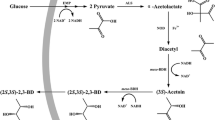Abstract
meso-2,3-Butanediol (meso-2,3-BDO) is essential for the synthesis of various economically valuable biosynthetic products; however, the production of meso-2,3-BDO from expensive carbon sources is an obstacle for industrial applications. In this study, genes involved in the synthesis of 2,3-BDO in Klebsiella pneumoniae were identified and used to genetically modify Escherichia coli for meso-2,3-BDO production. Two 2,3-BDO biosynthesis genes—budA, encoding acetolactate, and meso-budC, encoding meso-SADH—from K. pneumoniae were cloned into the pUC18 plasmid and introduced into E. coli. In 2 l batch culture, the SGSB03 E. coli strain yielded meso-2,3-BDO at 0.31 g/gglucose (with a maximum of 15.7 g/lculture after 48 h) and 0.21 g/gcrude glycerol (with a maximum of 6.9 g/lculture after 48 h). Batch cultures were grown under optimized conditions (aerobic, 6% carbon source, 37 °C, and initial pH 7). To find the optimal culture conditions for meso-2,3-BDO production, we evaluated the enzyme activity of meso-SADH and the whole cell conversion yield (meso-2,3-BDO/acetoin) of the E. coli SGSB02, which contains pSB02. meso-SADH showed high enzyme activity at 30–37 °C and pH 7 (30.5–41.5 U/mg of protein), and the conversion yield of SGSB02 E. coli was highest at 37–42 °C and a pH of 7 (0.25–0.28 g meso-2,3-BDO/gacetoin).




Similar content being viewed by others
References
Garg, S. K., & Jain, A. (1995). Fermentative production of 2,3-butanediol. A review. Bioresource Technology, 51, 103–109.
Kaloyan, P., & Petrova, P. (2009). High production of 2,3-butanediol from glycerol by Klebsiella pneumoniae G31. Applied Microbiology and Biotechnology, 84, 659–665.
Sadahar, U. U., Okajima, Y., Mimura, A., Kanai, H., Kobayashi, T., & Kudo, T. (1997). Sequence analysis of the gene for and characterization of d-acetoin forming meso-2,3-butanediol dehydrogenase of Klebsiella pneumonia expressed in Escherichia coli. Journal of Fermentation and Bioengineering, 83(1), 32–37.
Yan, Y., Lee, C.-C., & Liao, J. C. (2009). Enantioselective synthesis of pure (R, R)-2,3-butanediol in Escherichia coli with stereospecific secondary alcohol dehydrogenases. Organic & Biomolecular Chemistry, 7, 3914–53917.
Syu, M. J. (2001). Biological production of 2,3-butanediol. a review. Applied Microbiology and Biotechnology, 55, 10–18.
Blomqvist, K., Nicola, M., Lehtovaara, P., Suihko, M.-L., Airaksien, U., Strabe, K. B., Knowles, J. C., & Penttila, M. E. (1993). Characterization of the genes of the 2,3-butanediol operons from Klebsiella terrigena and Enterobacter aerogenes. Journal of Bacteriology, 175(5), 1392–1404.
Xiao-Jun, J., Huang, H., Zhu, J.-G., Ren, Lu-Jing, Nie, Z.-K., Jun, Du, & Li, S. (2009). Engineering Klebsiella oxytoca for efficient 2,3-butanediol production through insertional inactivation of acetaldehyde dehydrogenase gene. Applied Microbiology and Biotechnology, 85(6), 1751–1758.
Kamm, B., & Kamm, M. (2004). Principles of biorefineries. Applied Microbiology and Biotechnology, 64, 137–145.
Ledingham, G. A., & Neish, A. C. (1954). Fermentative production of 2,3-butanediol. In L. A. Underkofler & R. J. Hickey (Eds.), Industrial fermentations (Vol. 2, pp. 27–93). New York: Chemical Publishing.
Xiao, Z., & Xu, P. (2007). Acetoin metabolism in bacteria. Critical Reviews in Microbiology, 33(2), 127–140.
Sadahar, U. U., Okajima, Y., Mimura, A., Kanai, H., Kobayashi, T., & Kudo, T. (1997). Molecular generation of an Escherichia coli strain producing only the meso-isomer of 2,3-butanediol. Journal of Fermentation and Bioengineering, 84(3), 185–189.
Wayne, L. N. (2008). The Bacillus subtilis ydjL (BDOhA) gene encodes acetoin reductase/2,3-butanediol dehydrogenase. Applied and Environmental Microbiology, 74(22), 6832–6838.
Celinska, E., & Grajek, W. (2009). Biotechnological production of 2,3-butanediol—current state and prospects. Biotechnology Advances, 27, 715–725.
Sadahar, U. U., Masuda, H., & Muraki, H. (1983). Laboratory-scale production of 2,3-butanediol isomers (d(-), l(+), and meso) by bacterial fermentations. Journal of Fermentation and Bioengineering, 61, 253–259.
Saha, B. C., & Bothast, R. J. (1999). Production of 2,3-butanediol by newly isolated Enterobacter cloacae. Applied Microbiology and Biotechnology, 52, 321–326.
Yang, G., Tian, J., & Li, J. (2007). Fermentation of 1,3-propanediol by a lactate deficient mutant of Klebsiella oxytoca under microaerobic conditions. Applied Microbiology and Biotechnology, 73, 1017–1024.
Paulo da Silva, G., Mack, M., & Contiero, J. (2009). Glycerol: A promising and abundant carbon source for industrial microbiology. Biotechnology Advances, 27, 30–39.
Li, L., Wang, Y., Zhang, L., Ma, C., Wang, A., Tao, F., & Xu, P. (2011). Biocatalytic production of (2S,3S)-2,3-butanediol from diacetyl using whole cells of engineered Escherichia coli. Bioresource Technology. doi:10.1016/j.biortech.2011.08.097.
Ui, S., Takusangawa, Y., Sato, T., Ohtsuki, T., Mimura, A., Ohkuma, M., & Kudo, T. (2004). Production of l-2,3-butanediol by a new pathway constructed in Escherichia coli. Letters in Applied Microbiology, 39, 533–537.
Li, Z., Jian, J., Wei, X., Shen, X., & Chen, G. (2010). Microbial production of meso-2,3-butanediol by metabolically engineered Escherichia coli under low oxygen condition. Applied Microbiology and Biotechnology, 87, 2001–2009.
Zhu, Y., Eiteman, M. A., Lee, S. A., & Altman, E. (2010). Conversion of glycerol to pyruvate by Escherichia coli using acetate- and acetate/glucose-limited fed-batch processes. Journal of Industrial Microbiology and Biotechnology, 37, 307–312.
Acknowledgments
This research was supported by the R&D Program of Ministry of Knowledge Economy (MKE)/KEIT (no. 10035578, Development of 2,3-BDO and derivative production technology for C-Zero bio-platform industry). This work was supported by the Graduate School of Specialization for Biotechnology Program of the MKE.
Author information
Authors and Affiliations
Corresponding author
Rights and permissions
About this article
Cite this article
Lee, S., Kim, B., Park, K. et al. Synthesis of Pure meso-2,3-Butanediol from Crude Glycerol Using an Engineered Metabolic Pathway in Escherichia coli . Appl Biochem Biotechnol 166, 1801–1813 (2012). https://doi.org/10.1007/s12010-012-9593-z
Received:
Accepted:
Published:
Issue Date:
DOI: https://doi.org/10.1007/s12010-012-9593-z




